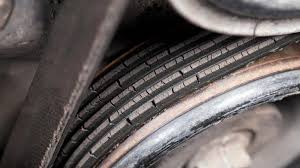


The term "serpentine belt" may bring up images of a scarey snake like object crawling around you engine, and that's actually pretty accurate, (except for the scary part). The serpentine belt is a long, belt that winds it way (like a serpent) around many of your vehicle's components. These can include the power the steering pump, alternator, and air conditioning compressor, and more, to the vehicle's crankshaft pulley. In some engines, the serpentine belt can also run the water pump, radiator fan, and supercharger.
Years ago, most engines had several V-type belts, but today, most modern engines have one ribbed serpentine belt responsible for running all of the accessory components. This belt can be tensioned automatically or manually. Automatically tensioned serpentine belts are the most common and are kept taught with a spring loaded tensioning mechanism. Manually tensioned serpentine belts are now less common and have a mechanical adjustment system comprised of threaded bolts, nuts, and adjustable slotted brackets. These are inconvenient due to the need for frequent tightening or the belts will become loose and begin to squeal, which causes excess heat, glazing and even breakiage.
The lifespan of the serpentine belt in our area is usually around 4 years. Serpentine belts can fail in a few different ways. The most serious failure is when the serpentine belt breaks completely. This is usually the result of a belt in poor condition, or a problem with one of the accessory components being driven by the belt. A failed bearing in a pulley being driven by the serpentine belt will also cause the belt to break.
Some possible consequences of a serpentine belt breaking while driving include: the illumination of warning lights on your dashboard, difficulty steering the vehicle, engine overheating, and the battery going dead in a few miles because the alternator would not be charging. A broken serpentine belt will have numerous negative effects on your engine and can potentially be dangerous.
There are many indicators that your serpentine belt may need to be replaced. Deep cracking in the ribs and spine of the serpentine belt is a common indicator your belt is due to be replaced. A noisy belt is also indicative of a problem. Your serpentine belt can also become contaminated with oil or coolant due to other issues with the vehicle. These contaminants will reduce the life of the belt and contribute to irregular noises.
At One Stop Automotive we take the time to visually inspect your serpentine belt, belt tensioner, and the accessory components driven by your serpentine belt every time you take your vehicle in for routine services. Serpentine belts typically give ample visual warning of impending failure. Driving your vehicle with an old and worn out belt can be a disaster waiting to happen.
We offer you peace of mind by inspecting your vehicle during regular maintenance so you never need to worry. Your serpentine belt will be inspected during regular service and replaced when necessary with your approval. And as always we offer a 3 year 36k parts and labor warranty on all eligible parts.